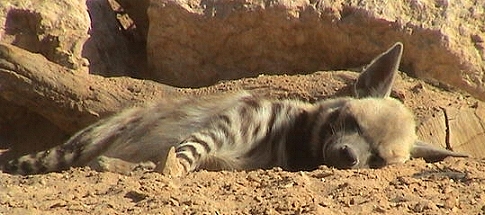
Striped Hyena

Striped Hyena
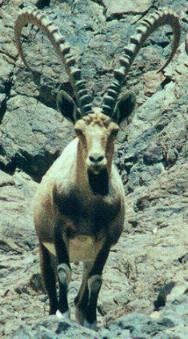 Male ibex in the Black Canyon |
From ancient times Israel's native mammals have had an important role in Jewish culture, featuring in colourful biblical metaphors and prophecies, as symbols of the tribes of Israel or discussed at length in the dietry codes so central to the Jewish culinary tradition. The young David battles a bear and a lion, and Samson struggles with a juvenile lion. Torah scrolls are written on parchment from deer or antelope skins, the Jewish New Year is commemorated by blowing on the ram's horn and the very Land of Israel itself is described as the "Land of the Gazelle".
Sadly the local lions and bears are now extinct, but most of Israel's native mammals familiar from the bible and folklore remain - the jackal and the gazelle, the rock hyrax and the ibex,the wolf and the leopard, the wild boar and the hare. The rapid pace of human development over the last 150 years has for the most part not been kind to Israel's large mammals, while recent years of drought have also caused numbers to dwindle, especially in the south, but the last few decades have seen major conservation projects which have brought many species back from the brink of regional extinction. Others remain endangered, but protected by Israel's nature protection laws, though the future of species such as the Negev leopards remains very much in doubt.
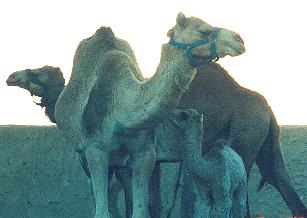 Camels in the Negev desert |
And now for the camel question. I have had several questions from people who were under the impression that in Israel our most common mammals are camels and that there are camels running around all over the place. Well the only 'wild' camels you'll see roaming the desert in Israel are in fact dosmetic herds whose owners allow them to roam. Others are old or injured camels which are no longer capable of working and have been set free by their Bedouin owners. Some of these camels have gone feral.
Keep an eye out for camels when driving in desert areas, esepcially at night, trust me, you really don't want to run into one. Triangular hazard signs with a picture of a camel are common along desert roads. Aside from these regions, camels aren't a very common sight, in fact in most parts of Israel there are no camels at all- except in zoos. You're far more likely to see a donkey - though they're generally of the domestic variety too. That's that out of the way.
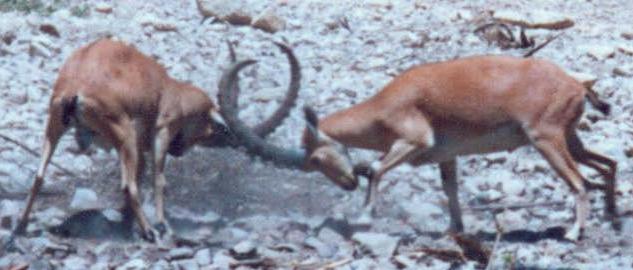
Male ibex locking horns at Ein Gedi oasis national park near the Dead Sea
Some wild animals you are likely to see while touring the country include ibex, hyrax and gazelle.
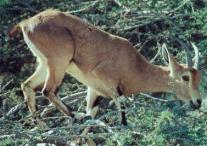 ibex foraging in an acacia tree |
The biblical verse "High mountains for ibex and rocks to shelter hyrax" (Psalms 104:18) aptly describes where one might spot these creatures. One of the best places to see both is the Ein Gedi oasis nature reserve near the Dead Sea where odds are most of the hyrax will be sheltered under or perched on top of rocks or bushes, while the ibex will be displaying their expert climbing skills on precarious mountain ledges.
The ibex is a kind of wild goat whose biblical Hebrew name is the ya'el. They are common around springs in the Negev and Judean deserts, where they are most likely to be seen nonchalantly walking along the edge of a high cliff or munching on desert foliage. Hungry ibex may even be seen perched atop acacia trees attempting to nip of the juiciest leaves.
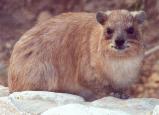 Rock hyrax at the Ein Gedi oasis |
Their agility is breathtaking, they nimbly clamber up and down even the steepest cliffs and most unstable scree slopes, walking fearlessly on the precipitous edge of the deepest abyss. Sometimes I've come across them seemingly in the middle of nowhere, out in the desert where there is no obvious spring, but evidently some water source that only wiley ibex know about.
A few decades ago ibex were on the decline but thanks in part to the work of the Israeli nature reserves and parks authority they had been making a good recovery up until the drought of recent years. Despite this drought induced dip in numbers, Israel is still home to the largest ibex herds in the world, making it probably the easiest place to see these creatures in the wild as they are one of the most commonly seen animals in Israel's desert regions and as such the National Parks Authority has chosen an impressively horned male ibex as their official symbol.
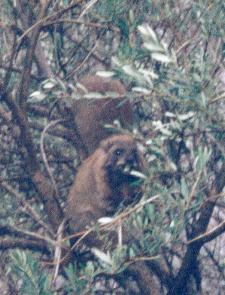 Hyrax feeding on an olive tree |
Syrian rock hyraxes are widely believed to be the biblical shafan, also known as the rock coney in English. The hyraxes of the Middle East are the only non-African members of the hyrax family. They are certainly amongst Israel's cutest animals and they're fascinating to watch. They are highly social animals, living in family groups with one adult who stands guard while the rest of the group feeds.
Their habitat reaches from the mountains of northern Israel all the way down the eastern deserts and mountains to Israel's southern tip at Eilat. Some of the best spots to look for them include the Ein Gedi oasis near the Dead Sea and the mountains of north-east Israel, near Nimrod's Fortress or the Banias national park.
The hyraxes that I've seen in north-east Israel are noticably darker and bolder than those that I've seen further south. The hyrax I've seen at Ein Gedi and at Ein Avdat have been a light reddish brown, some almost orange, while those up north have been more of a rich chestnut or dark brown, though I have seen lighter ones in the Golan Heights area too.
The gazelle is the biblical tzvi (its Hebrew name), an animal whose grace and beauty symbolise the Land of Israel, which is referred to as eretz hatzvi, the land of the gazelle. It is also a synonym for beauty in general, the beauty of the beloved is compared to a gazelle in several verses in Solomon's Song of Songs. Elsewhere in the bible the gazelle is a metaphor for speed.
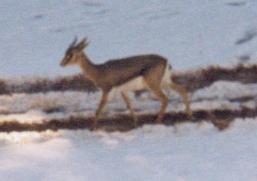 Israeli gazelle in snow in Jerusalem |
Gazelle are found in most parts of the country, the main exception being the densely populated central coastal region. There are two main species of gazelle in Israel, the Israeli or Mountain Gazelle, found in the northern two thirds of the country, and the Negev or Dorcas Gazelle which lives in the southern desert regions. The two species overlap in the Dead Sea region. There is also a subspecies of the Israeli Gazelle, endemic only to Israel, the endangered Arava Gazelle which lives in the southern Arava desert feeding mostly on the Acacia trees common to this region.
Even in regions with large gazelle populations it is not usually that easy to spot them as these shy creatures tend to be wary of people, perhaps because in many areas hunting has driven them to almost to extinction. The best time of day to see them is often around dawn or in the early evening, when they take advantage of the cooler, quieter hours to forage. In the centre of the country I've often been lucky to see them foraging on hillsides or in groves of trees by the roadside, or sometimes in clearings in the woods on the outskirts of Jerusalem.
Wild boar are perhaps Israel's most obnoxious large mammal, a lumbering creature renowned for its grumpy temper. The males do occasionally damage property in rural areas, uprooting trees or knocking down fences. It is certainly a creature to be approached with caution. They were once plentiful in many parts of the country though since it has become more densely populated and more developed they have retreated into the forests and more remote temperate areas. They are most likely to be spotted up north, especially on the Golan, where in spring you might see the female and her brood of curious offspring, their coarse bristles spotted and mottled to camoflage them from predators. While boar in Israel are not usually hunted for food as both Jews, and Muslims, the two largest religious groups in the country, consider them unfit for consumption, they are a popular game species for the limited number of Israelis with hunting permits.
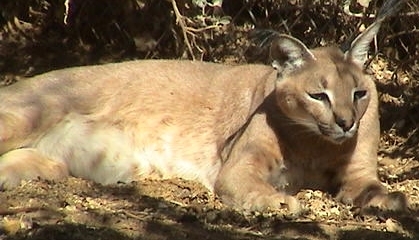
Caracal
While many of Israel's large carnivores such as lions and cheetahs were hunted to extinction long ago, there are still many impressive predators left, though several, are highly endangered.
Traditionally the maniacal cackling and howling of jackals was a common nighttime sound in most parts of the country, mentioned in many old Hebrew folk songs. Today you're only likely to hear it on the outskirts of town where there are plenty of undeveloped areas, forests or caves for them to hang out in during the day. Similar to the American coyote, jackals only come out at night, and, they usually keep well clear of humans; indeed, in the Bible they are a symbol of wilderness and desolation.
Their insane laughter like calls have earned them a spooky reputation, a factor which contributed to mass cullings of jackals in the 1950s when they were blamed for spreading rabies.
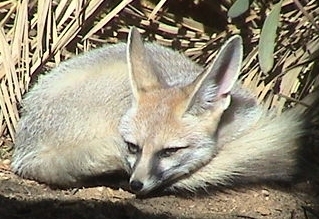 Blanford's fox |
Where food is plentiful they live in packs, but in some areas they go around in pairs. They are scavengers but will also hunt small creatures and will also eat fruits and insects if the opportunity presents itself.
I'll never forget coming face to face with a pair of them up close once in a village in northern Israel. I was out for an early walk just after dawn when I noticed two large yellowish animals with luxurious winter pelts standing by the path. I think the surprise was mutual, we just stared at each other for a few seconds and then they turned and ran back into the bushes. At night in the village we would hear their chilling calls right outside the windows, so close it sounded as though they might come inside at any moment.
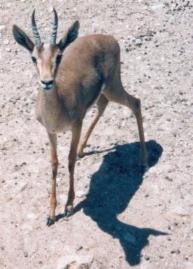 Desert Negev Gazelle |
Wolves are not common in Israel outside of sparsely-populated areas such as the desert and some parts of the Galilee and Golan in northern Israel. They are severely endangered in most of this region and to the best of my knowledge Israel is the only part of the Levant, or possibly the whole Middle East where they are a protected species, much to the annoyance of local cattle and sheep herders.
Israel is also home to striped hyaenas, but like the wolf, their territory tends to be restricted to areas which are sparsely populated, and is now most likely to be found in desert areas such as the Negev, Arava and Judean Desert, although populations do exist throughout Israel, save for the densely populated coastal plain and lowlands. My only clear sightings have been near the British Forest, south of Beit Shemesh when I spotted one running through a roadside field and once by the road near the southern desert town of Mitzpe Ramon.
The leopard, is Israel's only remaining big cat, though its future survival remains in doubt, with only a few individuals left in the Judean and Negev deserts, and possibly no surviving females. Other wild felines include caracals, bog cats and wild cats.
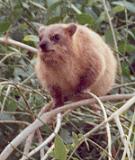 Rock hyrax in a tree |
The latter in particular is threatened by the ubiquitous feral domestic cat which plagues most urban areas in Israel, rather like racoons in north America or foxes in Europe. Some of these feral domestic cats interbreed with wildcats (probable ancestor of the domestic cat) creating hybrids, and infecting the wild cat population with diseases previously common only amongst domestic cats.
The most common truly wild urban predator is the red fox, a rather drabber dusty coloured cousin of the European species. They hang around the outskirts of towns, in fields, even in many desert regions where they live alongside desert species such as Blandford's and sand foxes.
Smaller predators include badgers, marbled polecats stone martens and the snake and fish hunting Egyptian mongoose.
Israeli Wildlife |
Biblical Animals |
Hai Bar Conservation Programme
Israeli Mammals |
Small Israeli Mammals |
Israeli Reptiles |
Israeli Birds |
Israeli wildlife links
Copyright 2010 by Leiah Elbaum. Text and photographs on this page are by Leiah Elbaum. Last updated 26 December 2010.